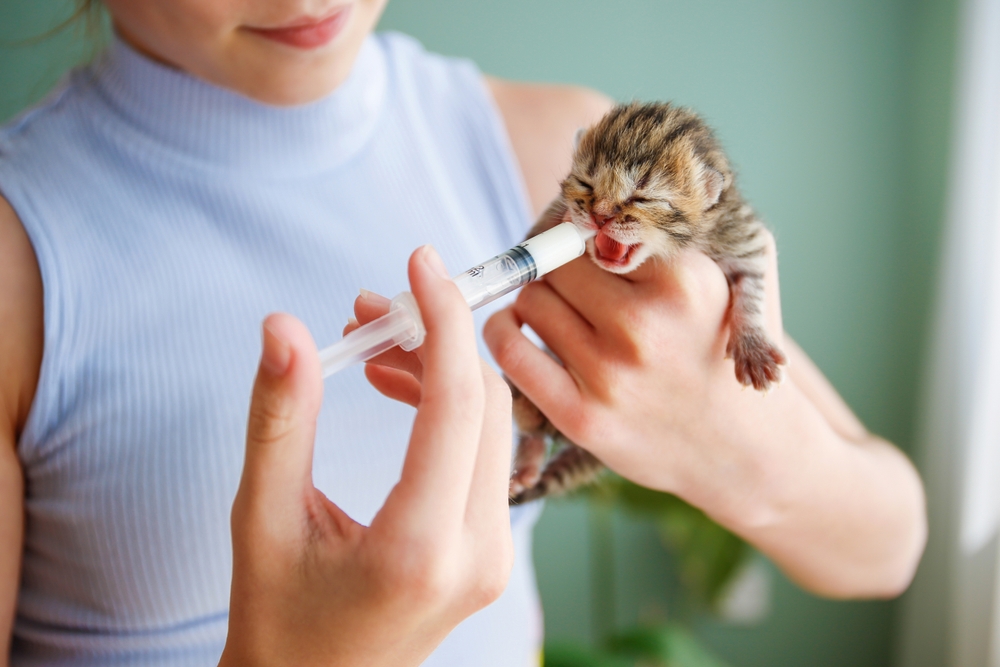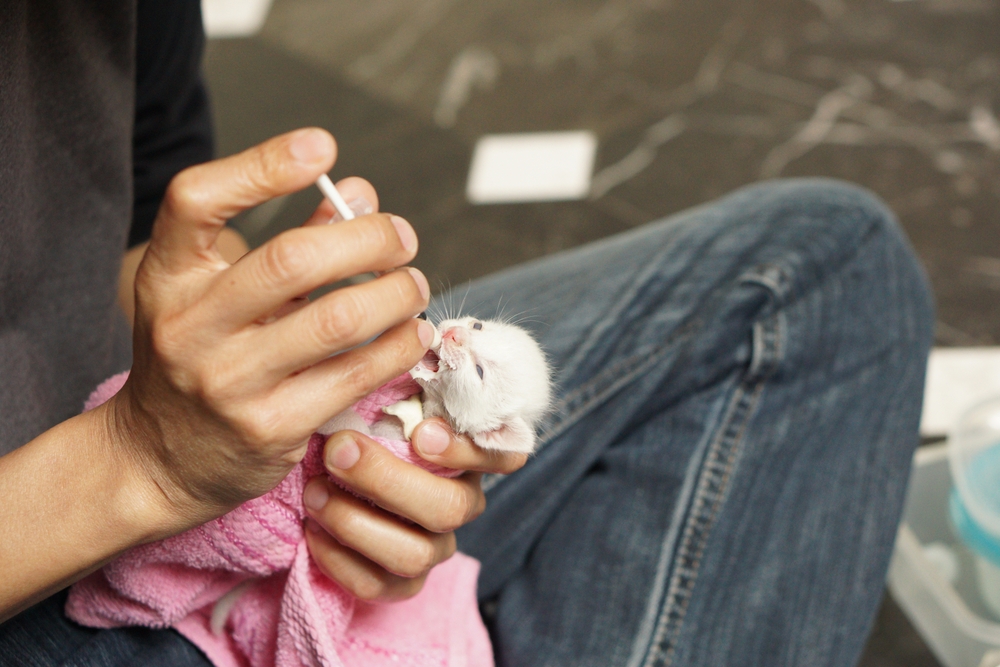Syringe feeding a cat is a method by which you are “forcing” food into the side of your feline’s mouth. But why on Earth would you even need to force-feed your cat? Can’t she eat her food on her own?
Well, as we have all learned by now, our feline companions are very private creatures and masters of hiding when they’re in any kind of pain or discomfort. So, when they’re going through certain medical issues, they usually lose their appetite.
This is exactly why they might need a little help from their human friend with getting all those much-needed nutrients into their little bodies. Also, the majority of orphaned kittens need to be syringe fed by their human parents in order to survive.
So, in today’s article, we are going to thoroughly discuss the complexity of syringe-feeding a cat. If you want to learn more, then keep on reading.
When should you syringe feed your cat?

The majority of cat parents give in to syringe feeding when their kitty is unable to eat or drink on her own due to young age or kittenhood, illness, or injury. They also do it when there is a certain medication their fluff needs to take and which she cannot take on her own.
Some of the most common illnesses because of which you would have to feed your cat using a syringe include upper respiratory infections, kidney or liver diseases, gastrointestinal upset, urinary complications, or diabetes.
And when it comes to common injuries, those usually revolve around dental problems like periodontitis, gingivitis, tooth resorption, and those alike.
However, sometimes the reason why you should consider syringe feeding a cat is when you notice your otherwise healthy fluff has lost her appetite. Usually, the main triggers are some psychological reasons, anxiety, and most commonly stress.
Bottle feeding vs. syringe feeding a kitten
Orphaned kittens who were devoid of their mother need all the help they can get from their owners while eating and simply have to be hand-fed. Most owners usually tend to choose bottles to feed their fluffs.
The process of bottle-feeding a kitten is fairly simple. Firstly, everything has to be sterile and clean. Secondly, the kittens have to be kept warm, positioned on their bellies, and never placed on their backs as that can result in them choking on the formula they are being fed.
The nipple of the bottle should have a small, poked hole so the food drips out of the bottle instead of running out of it. This will prevent the formula from exiting the bottle too fast and kittens from overeating.
Lastly, the temperature of the food should be between 99 °F and 101 °F, which is the standard feline body temperature. And the best way to warm it is to put the bottle into a bowl of hot water instead of microwaving it, for example.
However, some kittens simply won’t accept the nipple of the bottle. And that’s when syringe feeding a cat can greatly help you out!
From the newborn period until around one and a half weeks old, you should use the 3 cc syringe (without the needle, duh) and feed your kitten every 2 hours. Then switch to the 6 cc syringe and feed every 3 hours, and around 3 weeks move on to the 12 cc syringe and feed every 4 hours.
How to choose the right food for syringe feeding a cat?

When it comes to deciding what is the right food to syringe feed your cat, the best thing you can and should do is to consult your vet first. He will certainly know what is the best and most nutritionally balanced food for your kitty and her specific needs, and also what is the right portion size for her.
The food you are supposed to give your cat should be pre-measured, so you know exactly how many calories she has to consume. That food should also be puréed in a blender or a food processor with a bit of water.
Some experts suggest that you don’t purée your feline’s favorite food during the period of assistant eating as she can develop an aversion to it. This, of course, applies to adult cats who have a certain illness or injury and therefore need help with eating.
And when it comes to kittens and their formula, we recommend you use the powdered form of kitten milk replacement, or basically any type of formula that is lump free and therefore able to pass through the syringe.
Never ever use cow milk as it is very bad for felines. Instead, try using goat milk and mix it with the formula instead of the water. By doing so, you’ll ensure your kitten gets all the vitamins and minerals she needs to grow strong.
What about syringes?
When it comes to choosing the right syringe for feeding your feline, you should know that feeding syringes are not the same as regular, medical syringes. When compared to regular syringes used for vaccinations, feeding syringes have longer and wider endings.
If your local pharmacy doesn’t have feeding syringes, a great alternative would be those curved-tip syringes, where you can simply cut off the tip and get your very own DIY feeding syringe.
Syringe feeding a cat: here’s how to do it!

Now that we have discussed all the basic and much-needed details, it is finally time to move on to the actual step-by-step guide on how to syringe feed a cat.
When you are syringe feeding a cat, it is vital that the whole thing is done slowly, safely, and correctly. Therefore, to make sure you do it the right way, just follow these 5 simple steps and you will be good to go.
So, let’s not waste any more of your precious time and jump right into it!
1. Prepare your syringe
Before you use your feeding syringe, make sure you sterilize it in boiling water for no more than 5 minutes. This step will also make sure your syringe is warm once you put your cat’s food in it.
Of course, we do not have to mention that the syringe you are using has to be clean. If it has been used previously, make sure you wash it with a gentle detergent before you boil it in water.
2. Have the cat food prepared
Do not boil your syringe and then go to purée your cat’s food. Have it ready before, so you can easily load it in the feeding syringe once it cools down a bit and becomes safe for you to hold it without burning yourself.
However, do not make your food too early and place in it the fridge, so it doesn’t go bad. As we have already mentioned, the food should be warm enough for your kitty to enjoy it – not too hot nor too cold.
Its consistency should be fairly liquid if you are feeding a kitten, and more like a slushy or purée if you are feeding an adult cat.
There are two ways to load the food into the feeding syringe. The first one involves removing the back of the plunger and placing the food inside with a teaspoon or a butter knife.
The second one involves completely closing the syringe, placing the tip of it into the puréed food, and pulling back the plunger to suck the food inside. Which way you will choose totally depends on what works best for you. Generally speaking, the latter method works better for more liquid food.
3. Get your kitty ready

Make sure you are feeding your cat in a warm room. You can wrap her in a clean towel to make her comfy but also to protect your hands from her dangerous claws. With your non-dominant hand, keep her steady and calm, while holding the syringe with your dominant hand.
As we have already said, the best thing to do with a kitten is to place her on her tummy and syringe feed her like that. So, if you are feeding a kitten, burrito-wrap her too, and place her closer to you, so she can feel your warmth.
With an adult cat, you might need help from another person. If you do opt for this, make sure that person is someone with whom your feline is familiar. That person can hold the cat, while you can be the one feeding her.
4. Be slow and steady
With a feeding syringe in your dominant hand, place the tip of it on the sides or the back corner of your fluff’s mouth. Slowly push the back of the plunger until you both get familiar with it.
Make sure you are extra careful and not forceful. I’m sure you don’t want your kitty to choke on the food or for the food to go through her nose.
This feeding session can last anywhere between 5 and 15 minutes, depending on how cooperative your kitty is.
5. If your kitty refuses to eat – don’t force her!
Finally, we have to mention that if you notice your cat is refusing to swallow the food you’re feeding her through the syringe, stop immediately! By forcing your kitty to eat, you risk her choking on the food.
Instead, wait for her to calm down and then try again; or consult your vet on other methods you can try.
